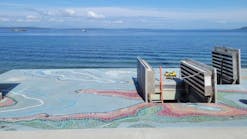Located in the heart of downtown Tacoma, Wash., the Thea Foss Waterway once was characterized by oil sheens, coal tar deposits and dilapidated buildings. In 1983, the U.S. Environmental Protection Agency (EPA) declared the Thea Foss Waterway part of the Commencement Bay Superfund site. The city responded by taking the lead in the design and cleanup. As a result, in 2006, the city of Tacoma and its partners completed a $105 million remediation of the waterway. This work was performed in coordination with an aggressive revitalization of the waterfront corridor.
Today, the waterway is the focal point for the city with a university, several museums, a revitalized downtown district, condominium developments, reconstructed marinas and a recently completed urban water quality research center. With millions of dollars invested and a legacy on the line, it is imperative that the city of Tacoma does what it can to avoid recontamination of the waterway, especially now that it has emerged as an economic and environmental asset to the community.
To ensure that the waterway remains the asset that was envisioned and has since become, the city of Tacoma embarked on an aggressive storm water management program in 2001 that included source control, maintenance, rehabilitation, treatment and education. To track the progress, these efforts were paired with extensive monitoring of storm water, baseflow and sediment throughout the watershed. Now the 12-year record of activity has been correlated with monitoring data, and the results are impressive. Data show significant improvement in the quality of storm water discharged to the Thea Foss Waterway. Furthermore, the data enable the city of Tacoma to better understand the effectiveness of individual management practices and tailor its program accordingly.
Tacoma’s Approach
The city of Tacoma began this program in 2001 with baseline monitoring of seven outfalls and upstream sediment monitoring to support source tracing efforts. The initial monitoring was essential to providing direction and prioritizing efforts of limited staff and resources. Staff began the work to find and eliminate the sources of contaminants such as mercury, polychlorinated biphenyls, polyaromatic hydrocarbons (PAHs) and others. Businesses were inspected and a spills hotline was initiated in partnership with a local nonprofit organization. As sources were identified and eliminated, sampling continued.
Improvements were subtle in the initial years of the program. In general, contaminant levels remained even or decreased slightly, although spills increasingly were reported and resolved. Business practices were improving and sources of legacy contaminants were located and removed. Because significant reductions were not yet identifiable, it became clear that additional methods would be required to make a sizeable improvement in storm water quality. City staff re-examined the data and initiated what is now known as Tacoma’s Enhanced Maintenance Program.
In the downtown area, elevated mercury levels frustrated investigators. Because a source could not be identified, it was theorized that legacy contaminants in the 100-year-old pipe could be resuspending and showing up in current monitoring data. A plan was developed to “scrub” the storm pipe for the entire drainage basin. This scrubbing requires significantly more effort than typical catch basin cleaning operations and the name “enhanced maintenance” was born.
During these enhanced maintenance operations, the outfall is plugged, the pipe is scoured with jetters and all cleaning water and solids are cleaned out and properly disposed of. No water used during the cleaning, or removed sediments, are discharged into the receiving water. The results from this single basin-wide activity were astounding, so the program was expanded. To date, tributary areas from five of the seven outfalls into the Foss Waterway have been treated in this fashion. Phthalates, solids, metals, PAHs and other contaminants from storm water sources have significantly decreased, thus ensuring the protection of the remediated waterway.
Significant Reductions
Tacoma’s Enhanced Maintenance Program has proven to be an effective and cost-efficient model that could be duplicated in other municipalities. Over the 12-year period (August 2001 to September 2013), storm water and sediment have been sampled at the seven major outfalls that discharge into the Thea Foss and Wheeler-Osgood Waterways. This depth of data provides the basis for meaningful statistical evaluation.
As of 2013, 90% of the time, trends showed statistically significant decreases (44 out of 49 trends). The remaining 10% of the trends were level.
Reductions included:
- • Solids. Approximately 61% to 65% reduction in four of the seven outfalls;
- • Lead. Approximately 42% to 66% reduction in five of the seven outfalls;
- • Zinc. Approximately 30% to 55% reduction in all seven outfalls;
- • PAHs. Approximately 89% to 98% reduction in
- phenanthrene, indeno(1,2,3-cd)pyrene and pyrene in all seven outfalls; and
- • Bis(2-ethylhexyl)phthalate. Approximately 61% to 92% reduction in all seven outfalls.
As shown by these reductions in various constituents of concern, the improvement in storm water quality since the mid-1990s demonstrates that efforts by the city and others in the Thea Foss Watershed have been effective in reducing chemical concentrations in storm water.
The sediment in the waterway, however, are the true barometers. Monitoring performed by the city in 2013 showed that the data were generally consistent with model predictions, and that the Foss Waterway’s risk of recontamination is low.
Tacoma’s Success
The transformation of the Thea Foss Waterway has astonished stakeholders. It now is an economic asset, open for boating, paddle boarders and Tacoma’s large community of canoers and kayakers. Property values in the waterfront area have increased eight-fold and the habitat within the waterway is recovering. From blighted to beautiful, the entire community has hailed the cleanup of the bay as a landmark achievement.
Since completing the cleanup in 2006, Tacoma has been nationally recognized as one of 12 Clean Water Clusters in the country by EPA and also has been recognized as an Innovation Partnership Zone by the state of Washington.
The work is not finished. The city’s data set tells civic and community leaders that there is much more that can be accomplished. The ultimate goal is to move beyond “clean enough” and achieve a higher standard.
Tacoma’s waterways are public assets, as important to life and livelihoods as clean air and a strong economy. While Tacomans have long felt that protecting their waterways for the health and vitality of the ecosystem and community was important, they now know how to do it successfully and that their efforts are reducing contaminant levels and making a real difference in the waters around Tacoma.
Download: Here


